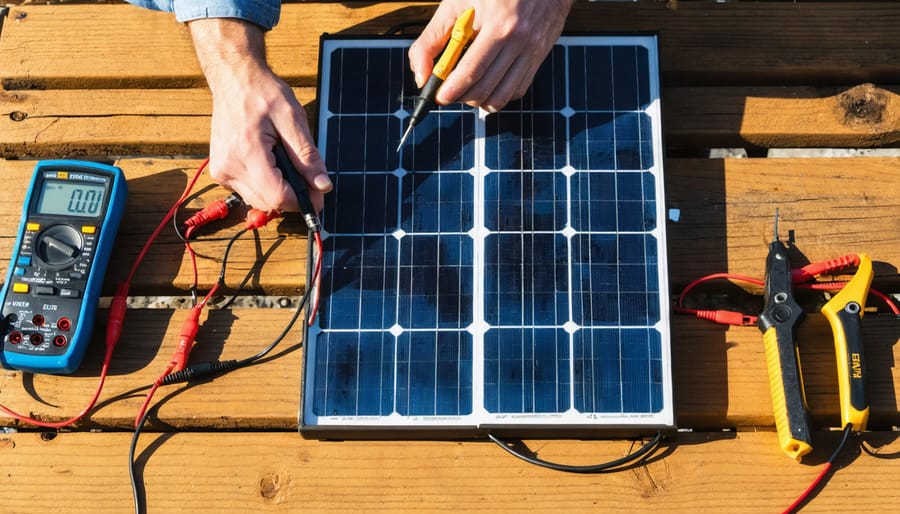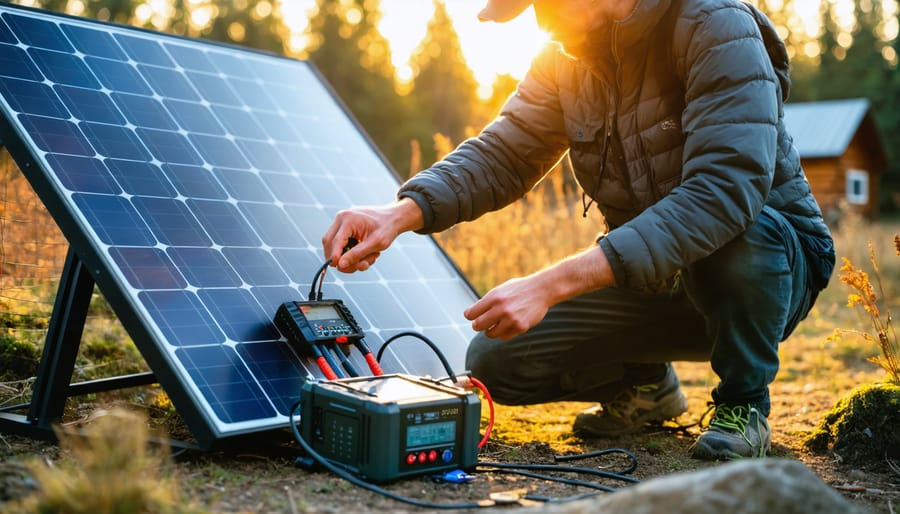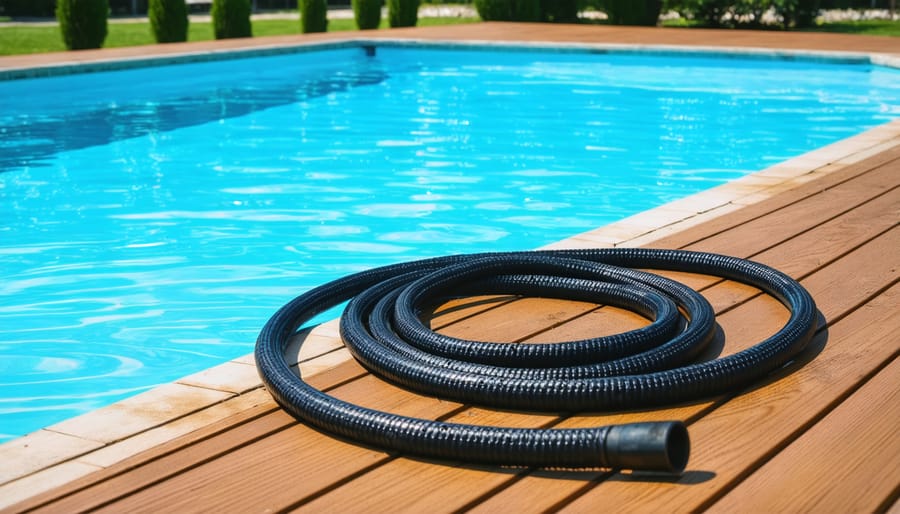Solar Panel Charge Time Calculator
Updated:

The factors affecting the charging process differ when charging a battery with a solar panel instead of a regular charger.
Hence, the need for a solar panel charge time calculator is different from a regular battery charge time calculator.
How to Use Our Solar Panel Charge Time Calculator
- Enter your battery voltage in the corresponding field.
- Enter your battery capacity in amp-hours in the given field: If your battery’s capacity is not in amp-hours – for instance, if it is in watt-hours – do watt-hours to amp-hours conversion. Then enter the resulting amp-hours in the field.
- Choose your battery type: Choose one of the two options provided (lead acid and lithium (LiFePO4). The battery type is essential to the solar panel charge time calculator’s work. For one, it can give a general idea about your battery’s discharge depth.
- Enter your battery’s depth of discharge (DoD): This step is optional. But with it, calculating the battery charging time is more accurate. Your battery’s DoD is basically how much of the battery capacity that’s been discharged. For instance, if your battery’s charge level is 30%, the battery’s DoD would be 70% (100-30). With DoD, instead of calculating the time it will take to get the battery system from 0% to 100%, the calculator will calculate how much time it will take to get to 100% from the current charge level.
- Enter your solar panel wattage in its input field.
- Select your solar charge controller type from the list: There are two options: PWM and MPPT. The charge controller type determines the charge controller efficiency the calculator uses in its calculation. For MPPT controllers, efficiency is around 93-97%. But for PWM, it is about 75-80%.
- Lastly, click on the Calculate button for the result. When you click on the button, it will display the result in peak sun hours. It will also show a link to a calculator to determine the peak hours of your location.
How to Calculate Solar Charging Time
Using Battery Capacity and Solar Panel Current
A simple way to calculate your battery charging time when charging with your solar panel is to divide the battery’s capacity by the solar panel current:
\(battery\ charging\ time = \displaystyle {\frac {battery\ capacity}{solar\ panel\ current}}\)
If the capacity is in amp-hour (Ah):
\(battery\ charging\ time\ (h) = \displaystyle {\frac {capacity\ (Ah)}{solar\ panel\ current\ (A)}}\)
If capacity is in milliamp-hour (mAh), we’ll divide it by solar panel current in milliamps:
\(battery\ charging\ time\ (h) = \displaystyle {\frac {capacity\ (mAh)}{solar\ panel\ current\ (mA)}}\)
If capacity is in watt-hour (Wh), we’ll divide it by solar panel wattage:
\(battery\ charging\ time\ (h) = \displaystyle {\frac {capacity\ (Wh)}{solar\ panel\ current\ (W)}}\)
In many cases, the current of solar panels is not specified. But since their wattage and voltage would most likely be specified, we can calculate their current:
\(solar\ panel\ current\ (A) = \displaystyle {\frac {panel\ wattage\ (W)}{panel\ volatge\ (W)}}\)
The battery charging time calculated using this method estimates the actual charging time. It gives an idea of how long the battery will take to charge.
But then, in reality, various factors affect the charging rate. So, we must consider those factors for utmost accuracy while calculating charging time.
Example 1
How long will it take to charge the batteries if we try charging a 100Ah, 12V battery bank with two 120W solar panels?
We can solve this by calculating the battery power capacity (Wh) before dividing it by the total wattage of the solar panels.
\(Capacity\ in\ Wh = capacity * battery\ voltage = 100Ah * 12V = 1200Wh\)
\(Total\ wattage\ of\ the\ solar\ panels = 120 + 120 = 240W\)
\(Battery\ charging\ time = \displaystyle {\frac {1200}{240}} = 5\ hours\)
Example 2
If one solar panel unit is rated 100W, how many solar panels do we need to charge a 150Ah, 24V battery in 6 hours?
To solve this, we’ll calculate the battery’s capacity in Wh first:
\(capacity\ in\ Wh = 150 * 24 = 3600\ Wh\)
Next, we’ll calculate the panel wattage that can charge the battery in 6h:
Since:
\(charging\ time\ (h) = \displaystyle {\frac {capacity\ (Wh)}{panel\ wattage\ (W)}}\)
\(panel\ wattage\ (W) = \displaystyle {\frac {capacity\ (Wh)}{charging\ time\ (h)}}\)
\(panel\ wattage\ to\ charge\ the\ battery\ in\ 6\ hours = \displaystyle {\frac {3600}{6}} = 600\ W\)
We need a total panel wattage of 600W to charge the battery in 6 hours, and one solar panel is 100W. So, the number of panels we need to charge the battery in 6 hours would be:
\(\displaystyle {\frac {600}{100}} = 6\ solar\ panels\)
Using Battery Capacity, Panel Wattage, Solar Charge Controller Efficiency, and Depth of Discharge
As mentioned in the previous section, various factors affect the charging rate of a solar system in real life. Amongst those factors are solar charge controller efficiency and depth of discharge (DoD).
Improving on the previous method, where we calculated the battery charging time using only the battery’s capacity and panel current, we’ll add charge controller efficiency and DoD to our calculation:
\(battery\ charging\ time\ (h) =\displaystyle {\frac {battery\ capacity\ (Wh) * DoD\ (\%)}{panel\ wattage\ (W) * charge\ controller\ efficiency\ (\%)}}\)
Most solar batteries come with their capacity stated in Ah. But since this method needs the battery’s capacity in Wh, we may have to convert Ah to Wh:
\(capacity\ in\ Wh = capacity\ in\ Ah * battery\ voltage\)
Example
A battery bank of three 80Ah, 12V solar batteries connected in series has a charge level of 35%. How long will a 300W solar array take to charge if connected to an MPPT charge controller fully?
We’ll use a charge controller efficiency of 93% to solve this since we are using MPPT.
First, we’ll calculate the battery bank’s capacity in Wh:
Since the batteries are in series, their total Ah would be 80Ah – their average capacity. However, their total voltage would be the sum of their individual voltages.
\(Battery\ bank’s\ voltage = 12 + 12 + 12 = 36V\)
\(Battery\ bank’s\ capacity\ in\ Wh = capacity\ in\ Ah * voltage = 80 * 36 = 2880\ Wh\)
Next, we’ll calculate DoD from the charge level:
\(DoD = 100\% – SoC = 100 – 35 = 65\%\)
Now that we know the battery bank’s capacity in Wh, we can calculate the charging time:
\(charging\ time\ =\displaystyle {\frac {2880 * 65\%}{300 * 93\%}} = \displaystyle {\frac {1872}{279}} = 6.7\ hours \approx 7\ hours\)
Using Battery Capacity, Panel Wattage, Solar Charge Controller Efficiency, Depth of Discharge, and System Losses
To make our estimation even more accurate, we can factor system losses into the formula used in the previous method:
\(battery\ charging\ time\ (h) =\displaystyle {\frac {battery\ capacity\ (Wh) * DoD\ (\%)}{adjusted\ solar\ output\ (W)}}\)
\(adjusted\ solar\ output =(panel\ wattage * charge\ controller\ efficiency) * ( 100\% – system\ losses)\)
The value of system losses varies. But for residential solar panels, the average is about 14%.
So, in the instance below, we’ll assume that system losses make up about 14% of the total solar power output.
Example
If we try charging a 100Ah, 12V battery bank at 40% charge with a 200W solar array connected to an MPPT charge controller, how long will it take? [Since it is an MPPT controller, we’ll use a charge controller efficiency of 93%]
To solve this, we’ll calculate the battery’s capacity in watt-hours first:
\(capacity\ in\ Wh = 100 * 12 = 1200\ Wh\)
Next, we’ll calculate DoD:
\(DoD = 100 – 40 = 60\ \%\)
Then, we’ll calculate the adjusted solar output using 14% as the value of system losses:
\(adjusted\ solar\ output = (200 * 93\%) * (100\% – 14\%) = 186 * 86\% = 186 * 0.86 = 159.96W\)
Now that we know the adjusted solar output, we can calculate the charging time:
\(charging time = \displaystyle {\frac {1200 * 60\%}{159.96}} = \displaystyle {\frac {720}{159.96}} = 4.5\ hours \approx 5\ hours\)
Factors that Affect the Solar Power Charge Time

Charge Controller Efficiency
Generally, MPPT charge controllers are more efficient than PWM charge controllers.
For this reason, when an MPPT controller is used with a solar charger, more solar energy is directed toward charging. Consequently, charging is faster.
Conversely, charging is relatively slower with PWM charge controllers because they are less efficient.
Depth of Discharge (DoD)
The DoD sums up how much of the battery’s capacity the solar charger must refill for the battery to be fully charged.
When the battery is fully discharged (DoD of 100%), the charger must refill the battery from 0% to 100%. Of course, this will take longer than when the charger only has to refill the battery from 40% to 100%.
Basically, the higher the DoD, the longer the charging time.
System Losses
Solar system losses are solar power losses due to real-life factors not considered or simulated when testing solar panels. One such factor is dust.
When panels are covered in dust, their efficiency drops. As such, they generate less energy, and charging is slower.
Battery Capacity
Generally, batteries with higher capacities take longer to charge under similar charging conditions than batteries with lower capacities.
This is so because the charger needs to supply more energy to higher-capacity batteries to get a full charge.
Solar Panel Size
When exposed to the same solar irradiance, solar panels with higher wattage generate more energy than those with lower wattage.
For this reason, they can charge faster than solar panels with lower wattages.
Peak Sun Hours
Peak sun hours are how many hours of the day the solar irradiance is at least 1000 watts per square meter. It gives an insight into the average hours of intense sunlight one can get in a location per day.
Of course, solar panels can produce more electricity with intense sunlight, solar panels can produce more electricity, and charging would be faster.
In other words, higher peak sun hours mean faster charging under the same charging conditions.
Battery Type
Depending on their battery type, batteries have different electrochemical properties, which affect their charging behavior.
For instance, while lithium batteries have a DoD of 100%, lead acid batteries can only safely have a DoD of 50%.
For this reason, lead-acid batteries of a similar rating as lithium batteries may charge faster under the same charging conditions.










